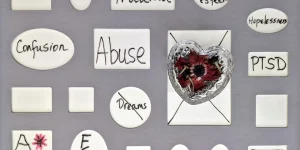3 Ways Traumatic Stress Appears & How to Manage It
Category: Trauma
It is not uncommon for people to have an experience where they are left feeling distressed. Often times, the event can be so traumatizing it causes us to feel stressed for days, weeks, months and sometimes even years after it took place. In this blog post, we will review three examples of what traumatic stress looks like and a couple strategies to help manage it.

Topic Of Discussion
1. What Traumatic Stress Looks Like Emotionally:
Your emotions may become extremely intensified. Examples of this may be: you have frequent anger outbursts Or it may be that you begin to have panic attacks that seem to come out of nowhere or you are unsure what caused them. Some people even feel great sadness as a symptom of traumatic stress.
Another way traumatic stress manifests emotionally is when people disconnect. When experiencing traumatic stress, one may disconnect from their emotions entirely. This is a protective response to prevent their nervous system from getting overloaded.
2. What Traumatic Stress Looks Like Physically:
Due to heightened emotions, one may experience physical symptoms of traumatic stress. This can appear as a variety of ways throughout the body. Some people may experience shallow or rapid breathing, chest pain, or headaches. Having tense muscles or feeling tense throughout the body are signs of possible traumatic stress. One may find themselves restless and having difficulty relaxing and sitting still.
While some people feel physical tension or pain throughout the body, this is not the case for everyone. Some may find themselves on the opposite of the spectrum. One may also find them feeling completely disconnected. It’s not uncommon for someone experiencing traumatic stress to zone out and lose awareness of their body and the world around them.
3. What Traumatic Stress Looks Like Mentally:
Traumatic stress also impacts how we feel cognitively. When experiencing symptoms of traumatic stress mentally, one may have racing thoughts focused on the present (and how to navigate the traumatic situation), the future (due to their vision of now being doubted), or towards that which is causing them traumatic stress.
Alternatively, one may have brain fog and not be able to access words or thoughts.
How to Manage It:
When experiencing traumatic stress, it is important to relax and ground your mind and body to make yourself feel safe. The National Alliance on Mental Illness offers several strategies to help individual cope with traumatic stress. We’ve highlighted some of our favorites below.
5-4-3-2-1 Exercise
5 – Look: Look around for 5 things you can see and say them out loud.
4 – Feel: Pay attention to your body and think of 4 things you can feel and say them out loud.
3 – Listen: Listen for 3 things you can hear (traffic, birds chirping, etc.) and say them out loud.
2 – Smell: Say 2 things you can smell. If you can’t smell anything at the moment, name your 2 favorite smells out loud.
1 – Taste: Say 1 thing you taste. If you can’t taste anything, name your favorite thing to taste.
4-2-6 Breathing Exercise
Breathe in through your nose to a count of 4. Hold it for 2. Breathe out slowly through your mouth for a count of 6. By doing this you are activating the part of your nervous system that helps your body calm itself.
Do you feel you suffer from traumatic stress and need additional help?
If so, visit our website or give us a call to schedule an appointment. Tri-Star Counseling would enjoy the opportunity to travel your journey with you to provide insight and strategies to help you heal from traumatic stress.


